Special Report
How Bad Is the Flu Season in Every State?

Published:
Last Updated:

The Centers for Disease Control and Prevention Friday reported that the geographic spread of influenza in Puerto Rico and 49 states except Hawaii remains “widespread;” The Atlanta-based agency said during its reporting week that ended on January 20 that the proportion of outpatient visits for influenza-like illness was 6.6%, well above the proportion of 2.2% reported across the country during the non-winter months.
Fears of a flu pandemic emerged early in the United States after hospitalizations spiked at the start of this year’s flu season. In addition to hospitalizations, during the second week of January, 6.3% of doctor visits nationwide were for flu or flu-like illnesses, versus the off-season average of 2.2%. Flu season appears to have started earlier and hit harder this year than in recent years.
Click image to enlarge
A flu pandemic can emerge anywhere and spread globally. The flu pandemic of 1918 killed as many as 100 million people — approximately 675,000 in the United States. Three flu pandemics have occurred since then, in 1957, 1968, and in 2009, when H1N1 (also known as the swine flu) killed approximately 12,469 Americans. The most prevalent strain of this year’s flu season has been identified as H3N2.
In an email to 24/7 Wall St., spokesperson for the Centers for Disease Control and Prevention Ian Branam said, “H3N2-predominant seasons have been associated with more severe illness especially among people older than 65 years and children.” So far this flu season, children under the age of five, 50-64 year olds, and senior citizens are the most at risk groups. People 65 and older are over four times more likely to be hospitalized with the flu than the average American.
While the current flu season is nowhere near 2009 levels, when flu cases spiked higher and earlier, the CDC is anticipating elevated influenza activity to continue for several more weeks. “This season is notable for the sheer volume of flu that is occurring in most of the country at the same time,” said Branam.
24/7 Wall St. reviewed influenza activity levels in every state using data from the influenza division of the CDC. Activity levels are as of the second week of January. Specifically, they measure the percentage of current outpatients reporting flu and flu-like illnesses compared to such reports over the past non-flu seasons. States with high activity levels are those where flu cases have exceeded the respective by the most.
Click here to see the how bad the flu season is in every state.
Click image to enlarge
Relatively high numbers of cases have been reported in most of the country. New York City, Puerto Rico, and 32 states reported high flu or flu-like illness activity. Every state except for Hawaii had widespread influenza activity as of the second week of January.
CDC epidemiologist Lynnette Brammer, in an interview with 24/7 Wall St., noted activity levels could be from illnesses other than the flu. However, “you don’t get to high [flu activity levels] with something other than influenza,” she added.
The flu activity levels listed here are relative to what you would expect them to be if flu were not circulating. Flu seasons vary considerably, however, and a host of factors make mapping the spread and intensity of influenza in order to compare states a surprisingly difficult task.
“I’ve been doing this for more than 20 years and I can’t tell you why in a given year one state gets hit really hard and another one doesn’t get hit as hard,” said Brammer.
Methodology
To identify the incidence of the flu in every state, 24/7 Wall St. reviewed the latest weekly influenza surveillance report prepared by the influenza division of the CDC. Influenza-like Illness activity levels (minimal, low, moderate, and high) are based on the difference between current and off-season average proportions of outpatient visits to health providers for flu-like illnesses. It is important to note that outbreaks occurring in a single city could cause a state to display high activity levels, and data collected may disproportionately represent certain populations within a state and therefore may not accurately capture influenza activity for the whole state. The percentage of patients with flu-like illnesses so far this flu season (October 1, 2017 through January 13, 2018) was calculated by 24/7 Wall St. using data reported weekly to the CDC.
Activity levels for states are measured against regional average patient visits for flu-like illnesses. Across the 10 regions, these baselines range from 1.3% of patients in the Denver region (Colorado, Montana, North Dakota, South Dakota, Utah, and Wyoming) to 4.2% in the Dallas region (Arkansas, Louisiana, New Mexico, Oklahoma, and Texas).
Each state’s 65 and over population was obtained from the U.S. Census Bureau’s 2016 American Community Survey. The number of primary care physicians for every 100,000 people in each state came from County Health Rankings & Roadmaps, a collaboration between the Robert Wood Johnson Foundation and the University of Wisconsin Population Health Institute.
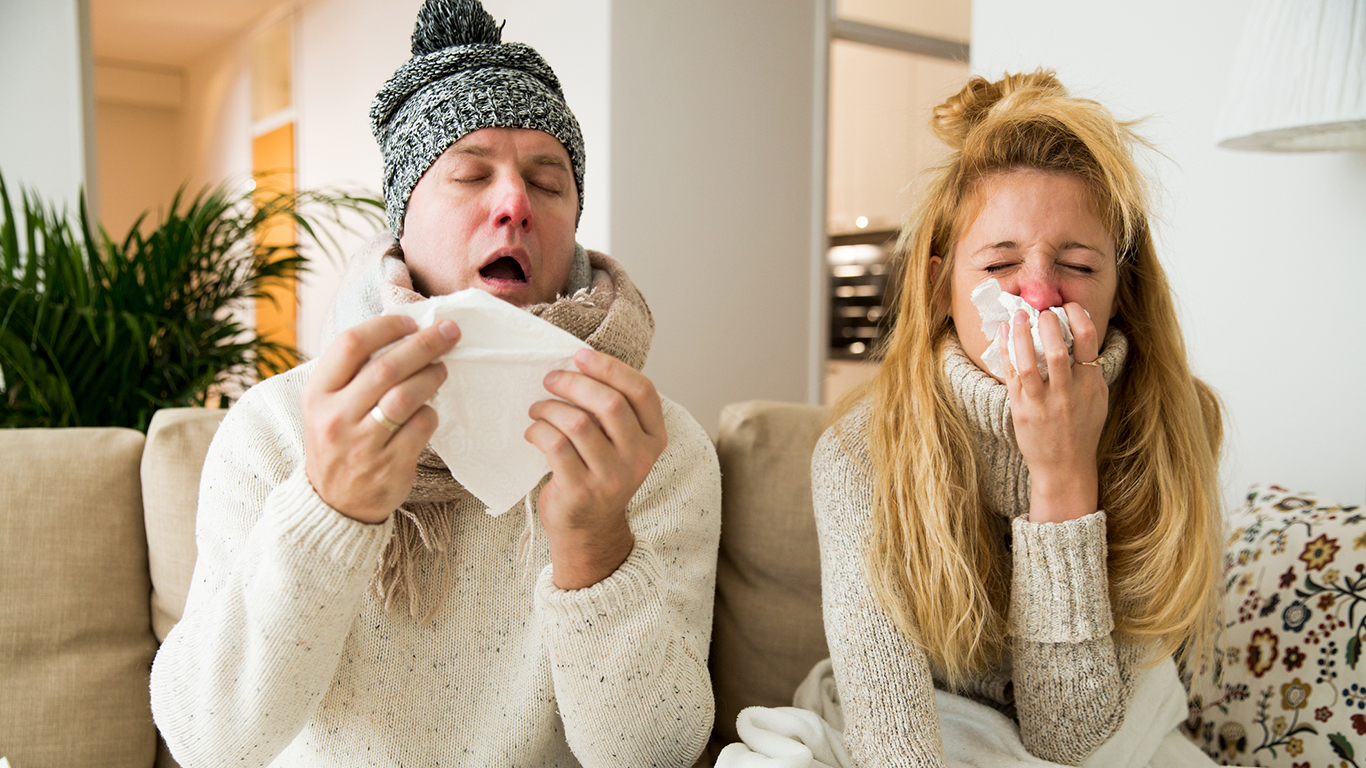
1. Alabama
> Flu-like illness activity level: High
> Flu-like symptoms so far this flu season (Oct 1- Jan 13): 4.5% of patients
> Flu-like symptoms in offseason (regional): 1.9% of patients
> 65 and over population: 16.1% (20th highest)
> 5 and under population: 7.2% (21st lowest)
[in-text-ad]

2. Alaska
> Flu-like illness activity level: Moderate
> Flu-like symptoms so far this flu season (Oct 1- Jan 13): 3.6% of patients
> Flu-like symptoms in offseason (regional): 1.4% of patients
> 65 and over population: 10.2% (the lowest)
> 5 and under population: 8.4% (5th highest)

3. Arizona
> Flu-like illness activity level: High
> Flu-like symptoms so far this flu season (Oct 1- Jan 13): 3.7% of patients
> Flu-like symptoms in offseason (regional): 2.4% of patients
> 65 and over population: 16.9% (10th highest)
> 5 and under population: 7.5% (19th highest)

4. Arkansas
> Flu-like illness activity level: High
> Flu-like symptoms so far this flu season (Oct 1- Jan 13): 3.6% of patients
> Flu-like symptoms in offseason (regional): 4.2% of patients
> 65 and over population: 16.3% (16th highest)
> 5 and under population: 7.5% (18th highest)
[in-text-ad-2]

5. California
> Flu-like illness activity level: High
> Flu-like symptoms so far this flu season (Oct 1- Jan 13): 2.8% of patients
> Flu-like symptoms in offseason (regional): 2.4% of patients
> 65 and over population: 13.6% (6th lowest)
> 5 and under population: 7.6% (15th highest)
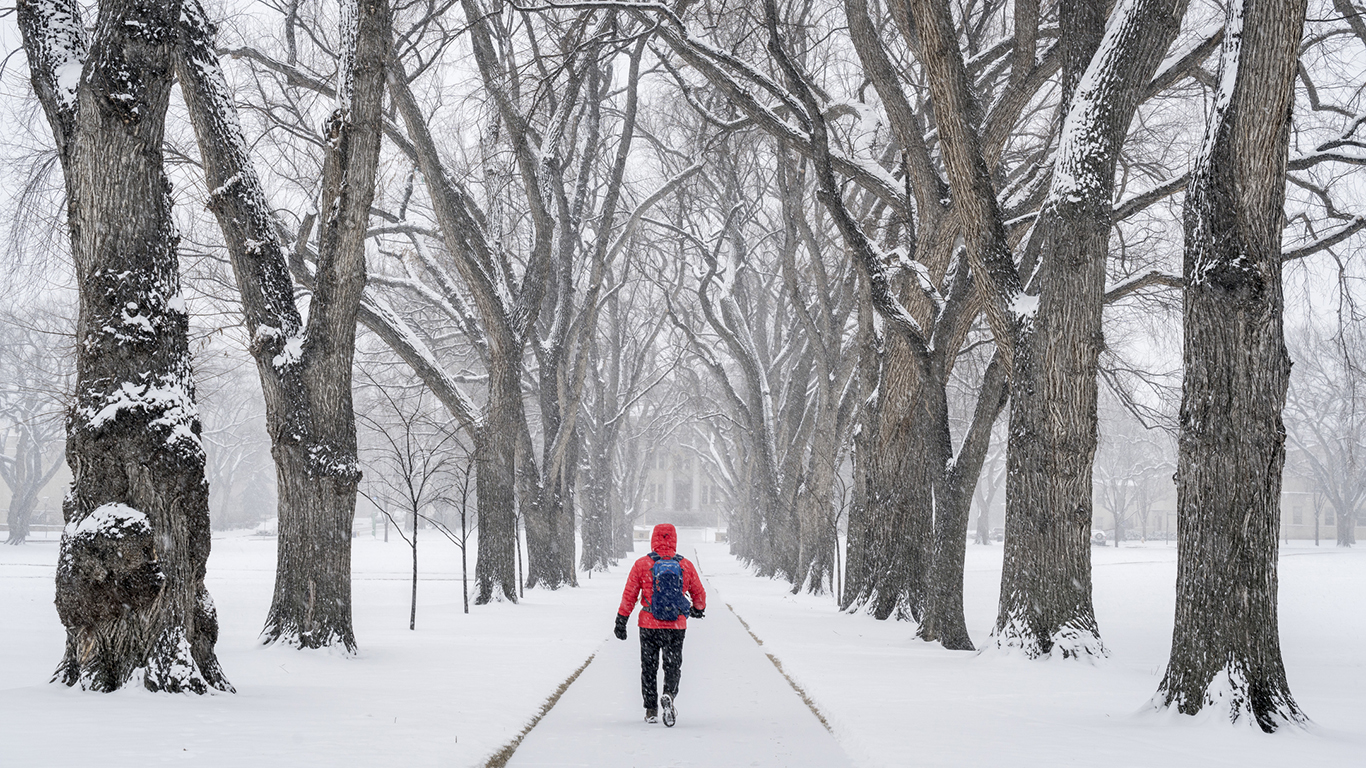
6. Colorado
> Flu-like illness activity level: Moderate
> Flu-like symptoms so far this flu season (Oct 1- Jan 13): 1.4% of patients
> Flu-like symptoms in offseason (regional): 1.3% of patients
> 65 and over population: 13.4% (5th lowest)
> 5 and under population: 7.2% (24th lowest)
[in-text-ad]

7. Connecticut
> Flu-like illness activity level: Low
> Flu-like symptoms so far this flu season (Oct 1- Jan 13): 2.1% of patients
> Flu-like symptoms in offseason (regional): 1.4% of patients
> 65 and over population: 16.1% (19th highest)
> 5 and under population: 6.2% (5th lowest)

8. Delaware
> Flu-like illness activity level: Insufficient Data
> Flu-like symptoms so far this flu season (Oct 1- Jan 13): 0.2% of patients
> Flu-like symptoms in offseason (regional): 2.0% of patients
> 65 and over population: 17.5% (6th highest)
> 5 and under population: 6.8% (10th lowest)

9. Florida
> Flu-like illness activity level: High
> Flu-like symptoms so far this flu season (Oct 1- Jan 13): Insufficient data
> Flu-like symptoms in offseason (regional): 1.9% of patients
> 65 and over population: 19.8% (the highest)
> 5 and under population: 6.5% (7th lowest)
[in-text-ad-2]

10. Georgia
> Flu-like illness activity level: High
> Flu-like symptoms so far this flu season (Oct 1- Jan 13): 3.8% of patients
> Flu-like symptoms in offseason (regional): 1.9% of patients
> 65 and over population: 13.2% (4th lowest)
> 5 and under population: 7.6% (17th highest)

11. Hawaii
> Flu-like illness activity level: High
> Flu-like symptoms so far this flu season (Oct 1- Jan 13): 4.1% of patients
> Flu-like symptoms in offseason (regional): 2.4% of patients
> 65 and over population: 17.0% (8th highest)
> 5 and under population: 7.6% (12th highest)
[in-text-ad]

12. Idaho
> Flu-like illness activity level: Moderate
> Flu-like symptoms so far this flu season (Oct 1- Jan 13): 1.2% of patients
> Flu-like symptoms in offseason (regional): 1.4% of patients
> 65 and over population: 15.2% (21st lowest)
> 5 and under population: 8.1% (7th highest)

13. Illinois
> Flu-like illness activity level: High
> Flu-like symptoms so far this flu season (Oct 1- Jan 13): 2.5% of patients
> Flu-like symptoms in offseason (regional): 1.8% of patients
> 65 and over population: 14.6% (11th lowest)
> 5 and under population: 7.2% (22nd lowest)
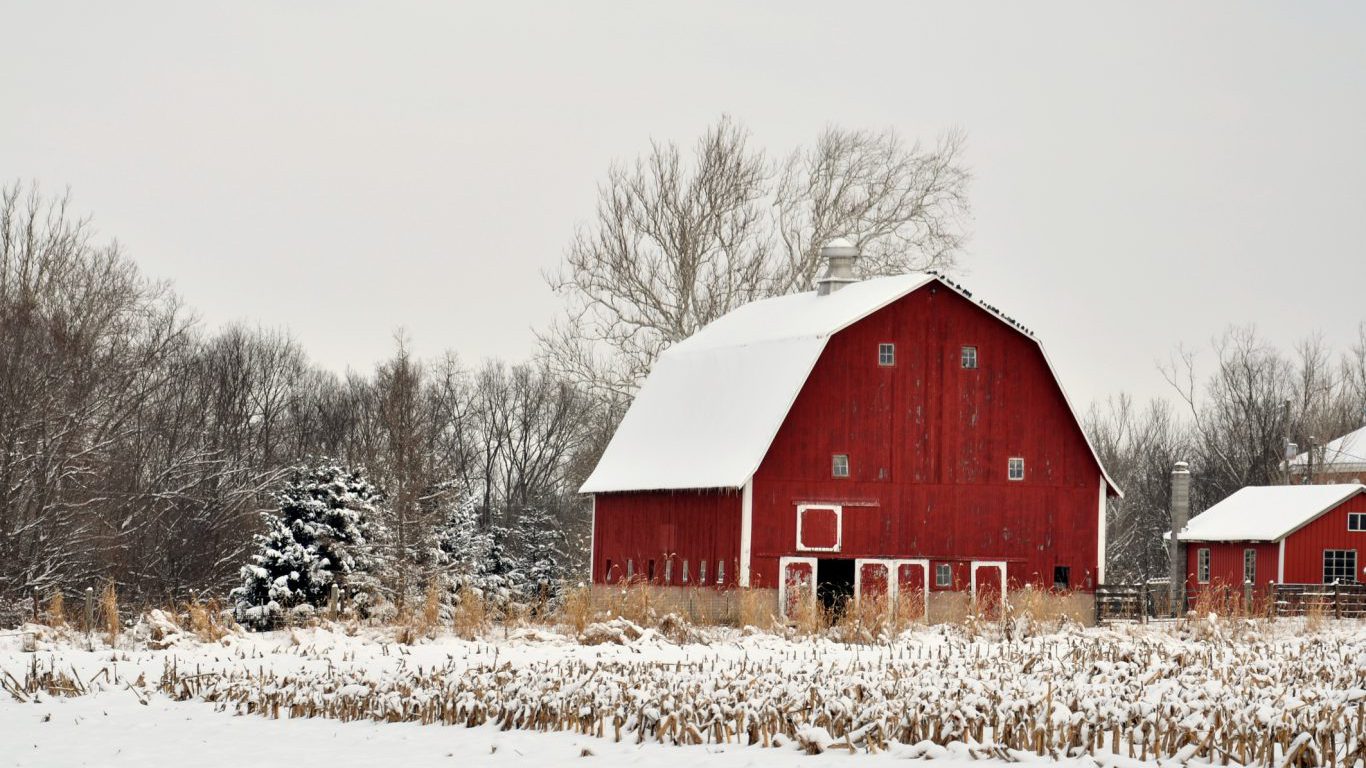
14. Indiana
> Flu-like illness activity level: High
> Flu-like symptoms so far this flu season (Oct 1- Jan 13): 2.4% of patients
> Flu-like symptoms in offseason (regional): 1.8% of patients
> 65 and over population: 15.0% (15th lowest)
> 5 and under population: 7.6% (14th highest)
[in-text-ad-2]
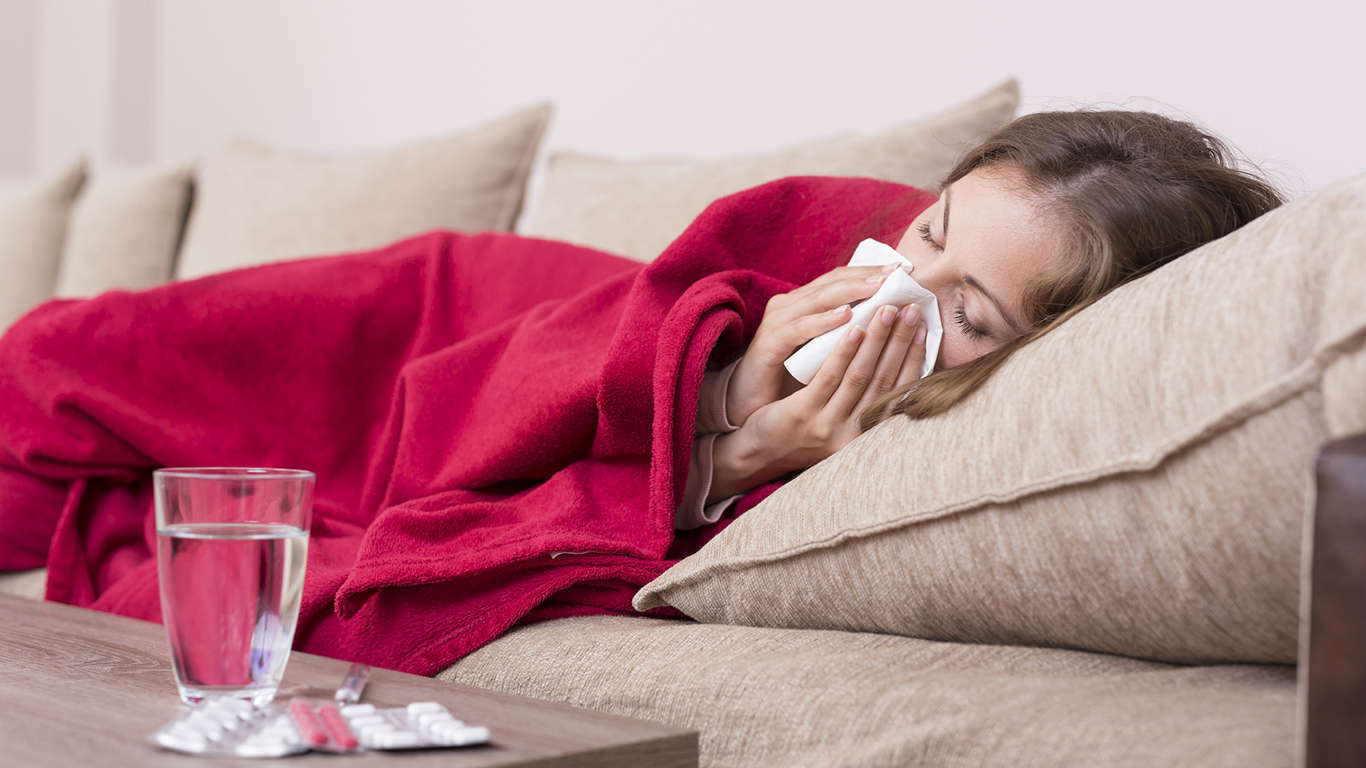
15. Iowa
> Flu-like illness activity level: Moderate
> Flu-like symptoms so far this flu season (Oct 1- Jan 13): 1.1% of patients
> Flu-like symptoms in offseason (regional): 1.9% of patients
> 65 and over population: 16.4% (15th highest)
> 5 and under population: 7.6% (16th highest)

16. Kansas
> Flu-like illness activity level: High
> Flu-like symptoms so far this flu season (Oct 1- Jan 13): 3.1% of patients
> Flu-like symptoms in offseason (regional): 1.9% of patients
> 65 and over population: 15.1% (20th lowest)
> 5 and under population: 8.1% (8th highest)
[in-text-ad]

17. Kentucky
> Flu-like illness activity level: High
> Flu-like symptoms so far this flu season (Oct 1- Jan 13): 3.6% of patients
> Flu-like symptoms in offseason (regional): 1.9% of patients
> 65 and over population: 15.5% (25th lowest)
> 5 and under population: 7.2% (25th lowest)

18. Louisiana
> Flu-like illness activity level: High
> Flu-like symptoms so far this flu season (Oct 1- Jan 13): Insufficient data
> Flu-like symptoms in offseason (regional): 4.2% of patients
> 65 and over population: 14.4% (7th lowest)
> 5 and under population: 7.8% (10th highest)

19. Maine
> Flu-like illness activity level: Insufficient Data
> Flu-like symptoms so far this flu season (Oct 1- Jan 13): 0.7% of patients
> Flu-like symptoms in offseason (regional): 1.4% of patients
> 65 and over population: 19.3% (2nd highest)
> 5 and under population: 5.9% (3rd lowest)
[in-text-ad-2]

20. Maryland
> Flu-like illness activity level: High
> Flu-like symptoms so far this flu season (Oct 1- Jan 13): 1.8% of patients
> Flu-like symptoms in offseason (regional): 2.0% of patients
> 65 and over population: 14.6% (9th lowest)
> 5 and under population: 7.2% (23rd lowest)

21. Massachusetts
> Flu-like illness activity level: Moderate
> Flu-like symptoms so far this flu season (Oct 1- Jan 13): 1.6% of patients
> Flu-like symptoms in offseason (regional): 1.4% of patients
> 65 and over population: 15.8% (24th highest)
> 5 and under population: 6.3% (6th lowest)
[in-text-ad]

22. Michigan
> Flu-like illness activity level: Minimal
> Flu-like symptoms so far this flu season (Oct 1- Jan 13): 1.8% of patients
> Flu-like symptoms in offseason (regional): 1.8% of patients
> 65 and over population: 16.2% (18th highest)
> 5 and under population: 6.9% (12th lowest)

23. Minnesota
> Flu-like illness activity level: Moderate
> Flu-like symptoms so far this flu season (Oct 1- Jan 13): 1.9% of patients
> Flu-like symptoms in offseason (regional): 1.8% of patients
> 65 and over population: 15.0% (18th lowest)
> 5 and under population: 7.6% (13th highest)
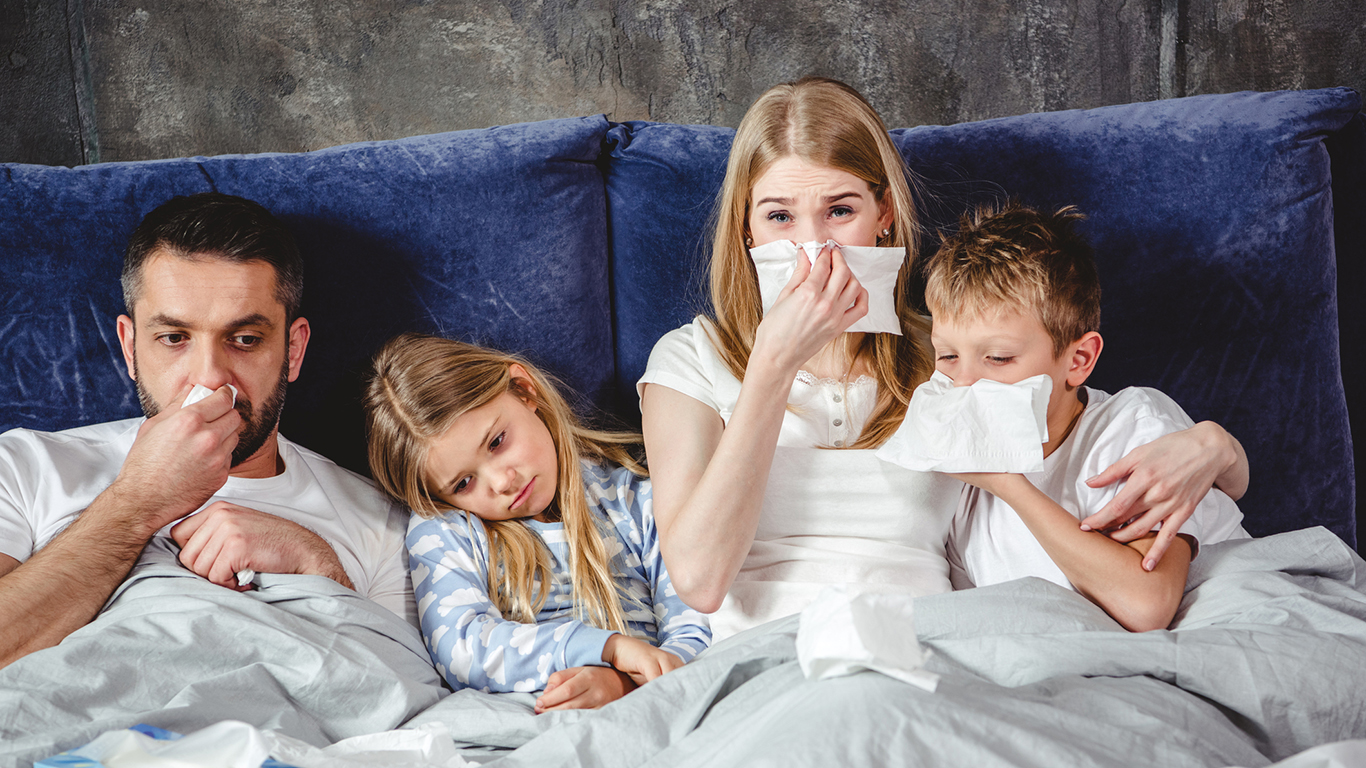
24. Mississippi
> Flu-like illness activity level: High
> Flu-like symptoms so far this flu season (Oct 1- Jan 13): Insufficient data
> Flu-like symptoms in offseason (regional): 1.9% of patients
> 65 and over population: 15.0% (19th lowest)
> 5 and under population: 7.5% (20th highest)
[in-text-ad-2]

25. Missouri
> Flu-like illness activity level: High
> Flu-like symptoms so far this flu season (Oct 1- Jan 13): 2.3% of patients
> Flu-like symptoms in offseason (regional): 1.9% of patients
> 65 and over population: 16.0% (22nd highest)
> 5 and under population: 7.3% (25th highest)

26. Montana
> Flu-like illness activity level: Minimal
> Flu-like symptoms so far this flu season (Oct 1- Jan 13): 0.1% of patients
> Flu-like symptoms in offseason (regional): 1.3% of patients
> 65 and over population: 17.6% (5th highest)
> 5 and under population: 7.1% (19th lowest)
[in-text-ad]
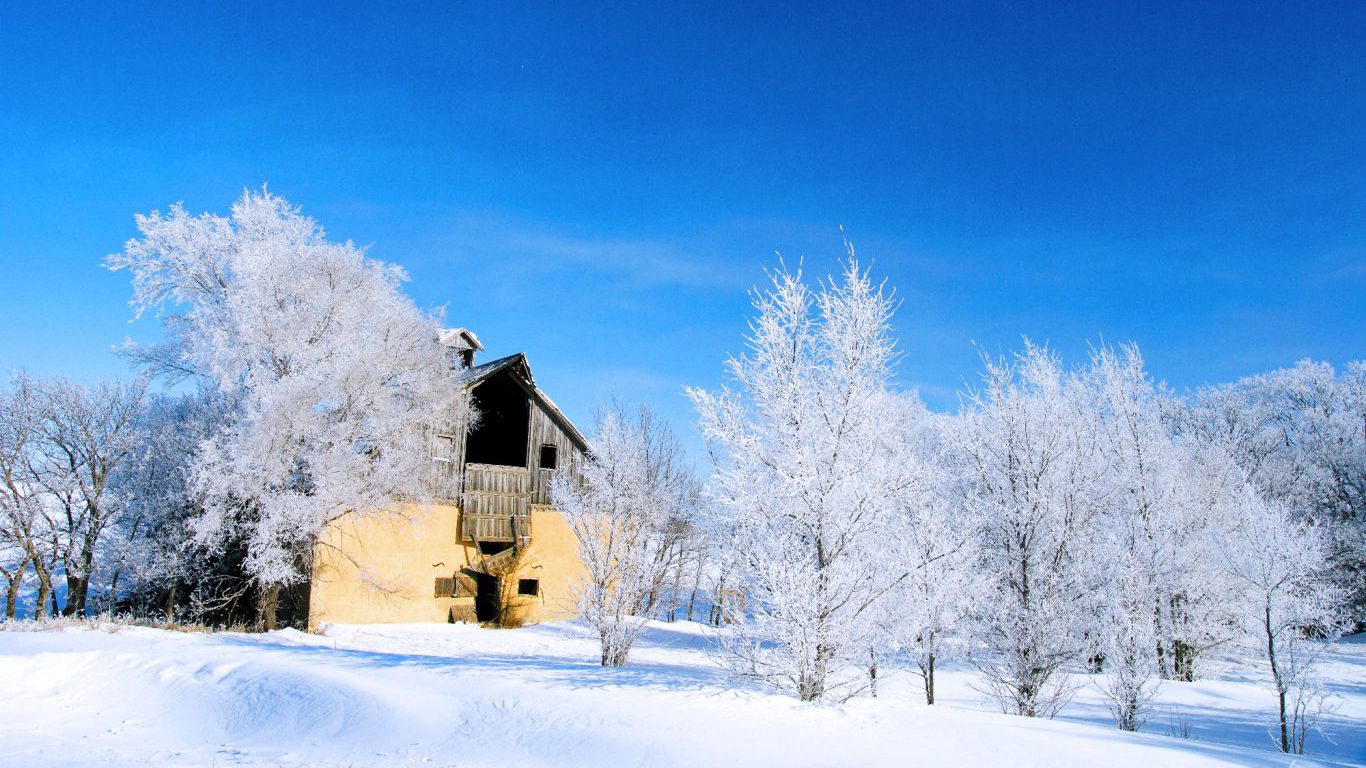
27. Nebraska
> Flu-like illness activity level: High
> Flu-like symptoms so far this flu season (Oct 1- Jan 13): 2.9% of patients
> Flu-like symptoms in offseason (regional): 1.9% of patients
> 65 and over population: 15.0% (14th lowest)
> 5 and under population: 8.3% (6th highest)
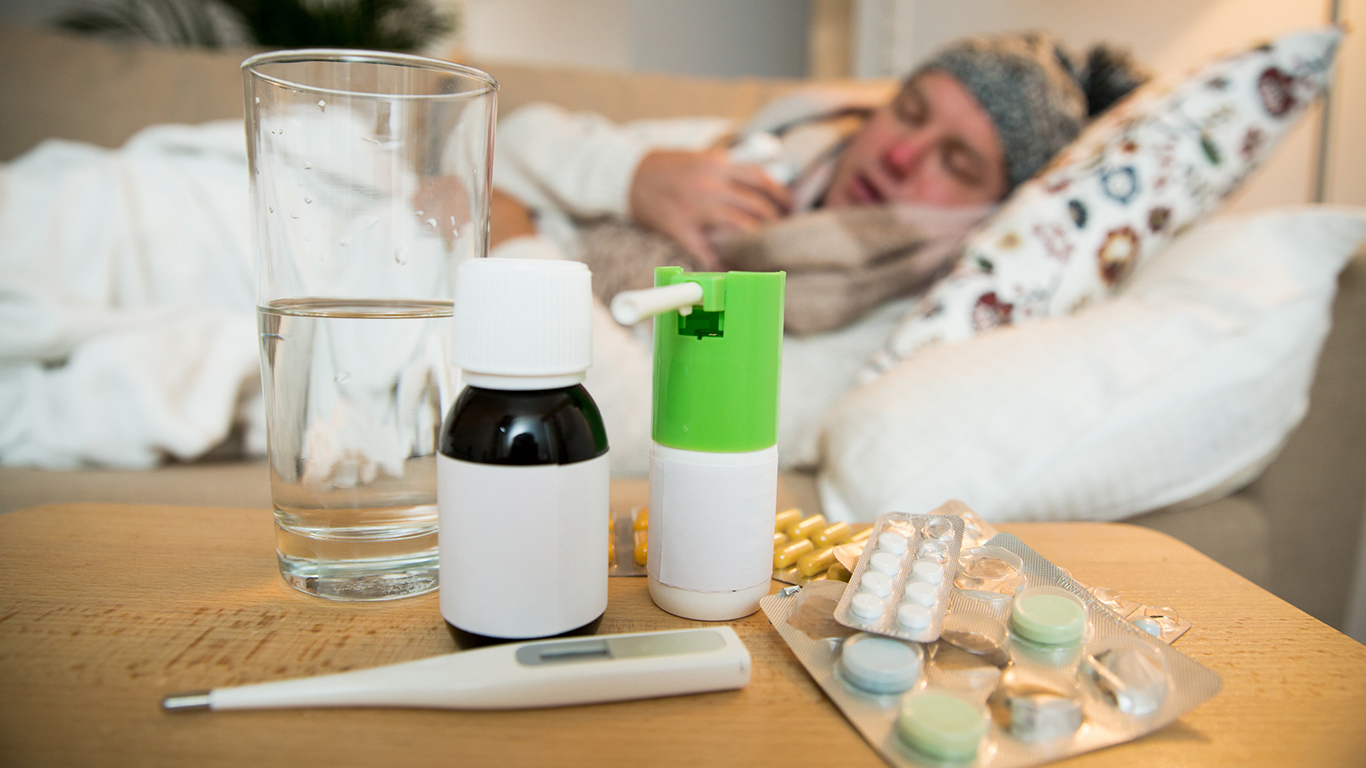
28. Nevada
> Flu-like illness activity level: High
> Flu-like symptoms so far this flu season (Oct 1- Jan 13): 1.7% of patients
> Flu-like symptoms in offseason (regional): 2.4% of patients
> 65 and over population: 15.0% (17th lowest)
> 5 and under population: 7.4% (21st highest)

29. New Hampshire
> Flu-like illness activity level: Low
> Flu-like symptoms so far this flu season (Oct 1- Jan 13): 0.7% of patients
> Flu-like symptoms in offseason (regional): 1.4% of patients
> 65 and over population: 17.0% (9th highest)
> 5 and under population: 5.9% (2nd lowest)
[in-text-ad-2]

30. New Jersey
> Flu-like illness activity level: High
> Flu-like symptoms so far this flu season (Oct 1- Jan 13): 2.9% of patients
> Flu-like symptoms in offseason (regional): 3.1% of patients
> 65 and over population: 15.3% (22nd lowest)
> 5 and under population: 7.1% (17th lowest)
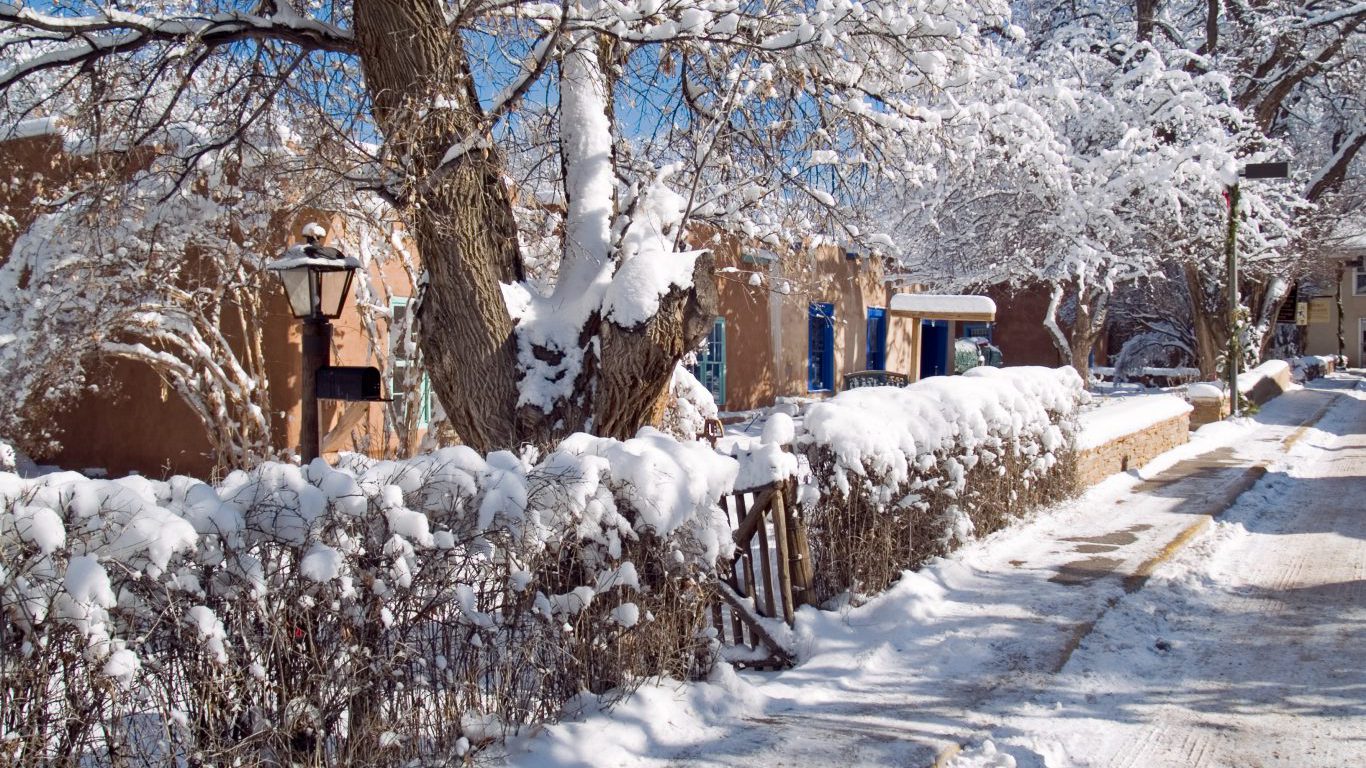
31. New Mexico
> Flu-like illness activity level: High
> Flu-like symptoms so far this flu season (Oct 1- Jan 13): 2.1% of patients
> Flu-like symptoms in offseason (regional): 4.2% of patients
> 65 and over population: 16.4% (14th highest)
> 5 and under population: 7.3% (23rd highest)
[in-text-ad]

32. New York
> Flu-like illness activity level: High
> Flu-like symptoms so far this flu season (Oct 1- Jan 13): 2.3% of patients
> Flu-like symptoms in offseason (regional): 3.1% of patients
> 65 and over population: 15.3% (23rd lowest)
> 5 and under population: 7.0% (14th lowest)
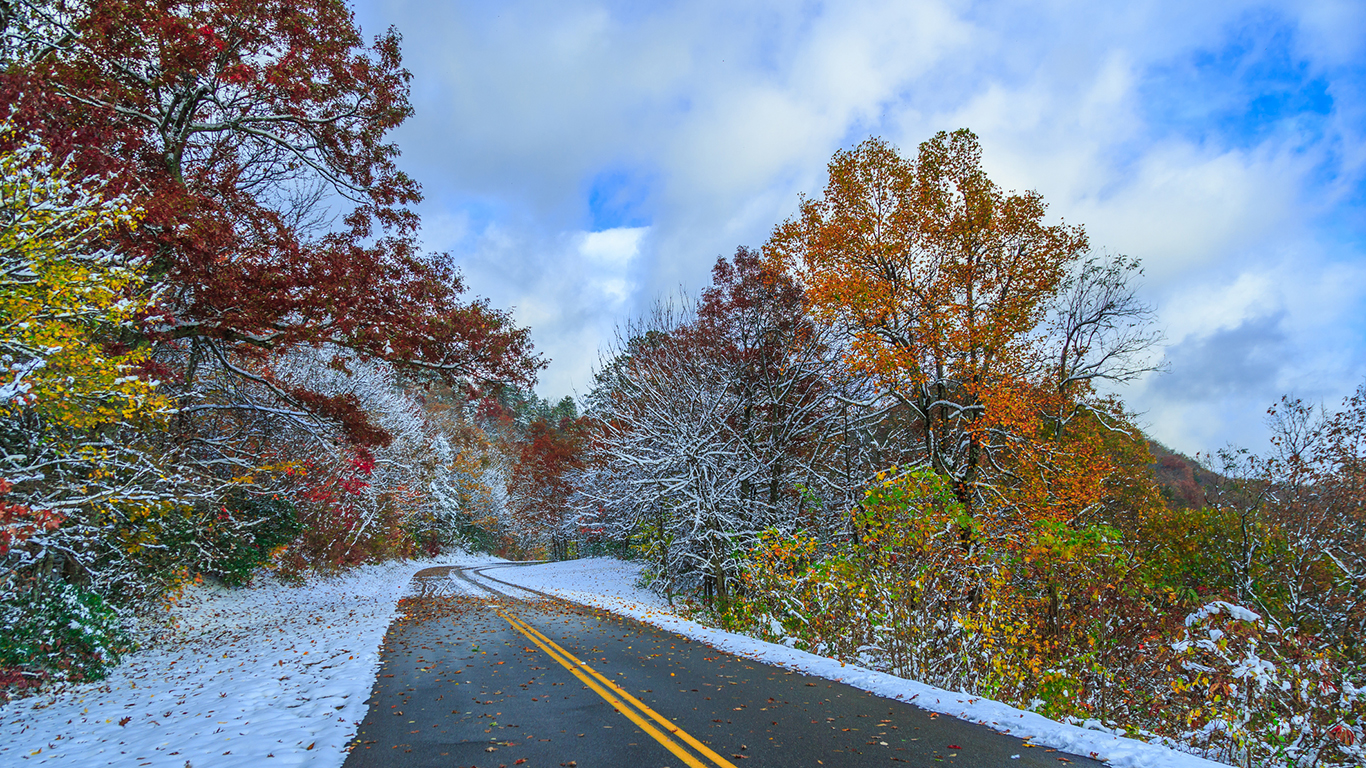
33. North Carolina
> Flu-like illness activity level: High
> Flu-like symptoms so far this flu season (Oct 1- Jan 13): 2.0% of patients
> Flu-like symptoms in offseason (regional): 1.9% of patients
> 65 and over population: 15.5% (24th lowest)
> 5 and under population: 7.0% (15th lowest)
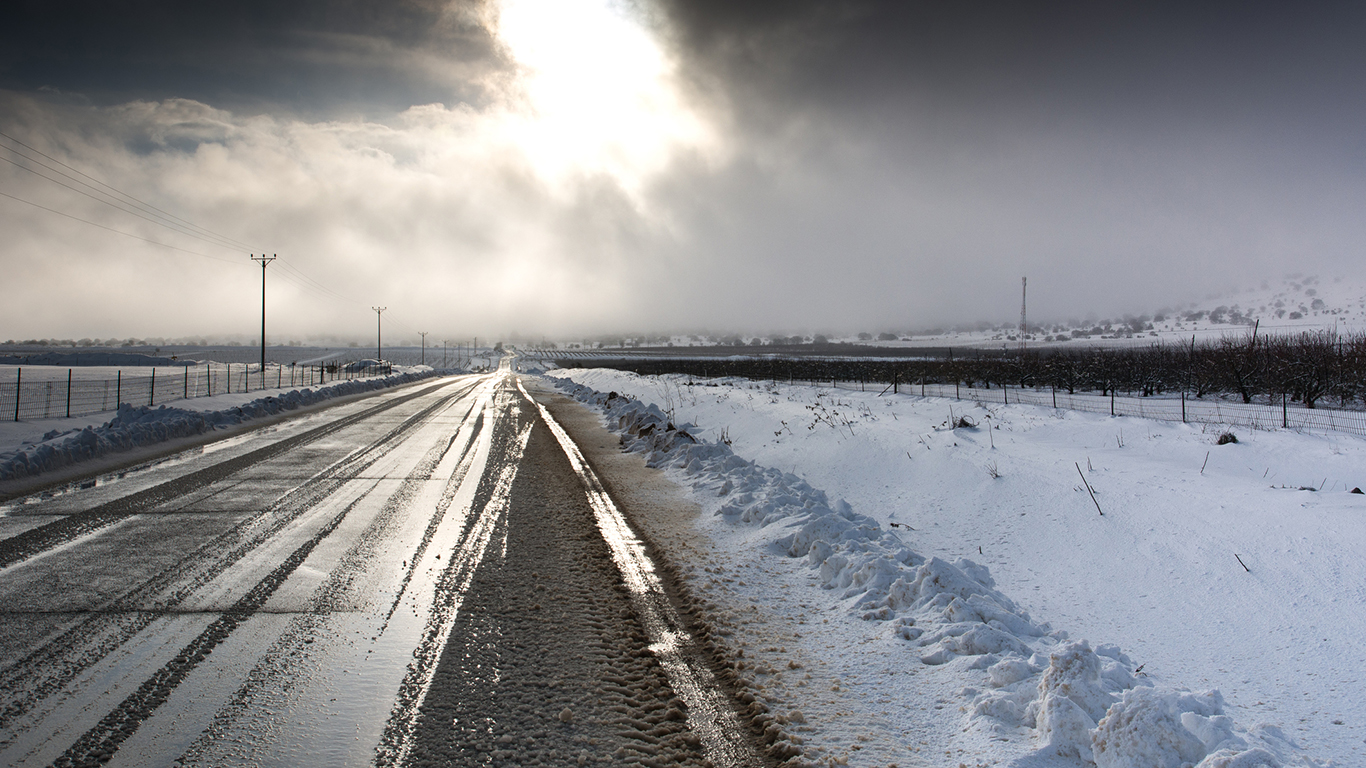
34. North Dakota
> Flu-like illness activity level: Moderate
> Flu-like symptoms so far this flu season (Oct 1- Jan 13): 1.5% of patients
> Flu-like symptoms in offseason (regional): 1.3% of patients
> 65 and over population: 14.5% (8th lowest)
> 5 and under population: 8.7% (2nd highest)
[in-text-ad-2]

35. Ohio
> Flu-like illness activity level: High
> Flu-like symptoms so far this flu season (Oct 1- Jan 13): 1.6% of patients
> Flu-like symptoms in offseason (regional): 1.8% of patients
> 65 and over population: 16.2% (17th highest)
> 5 and under population: 7.1% (18th lowest)
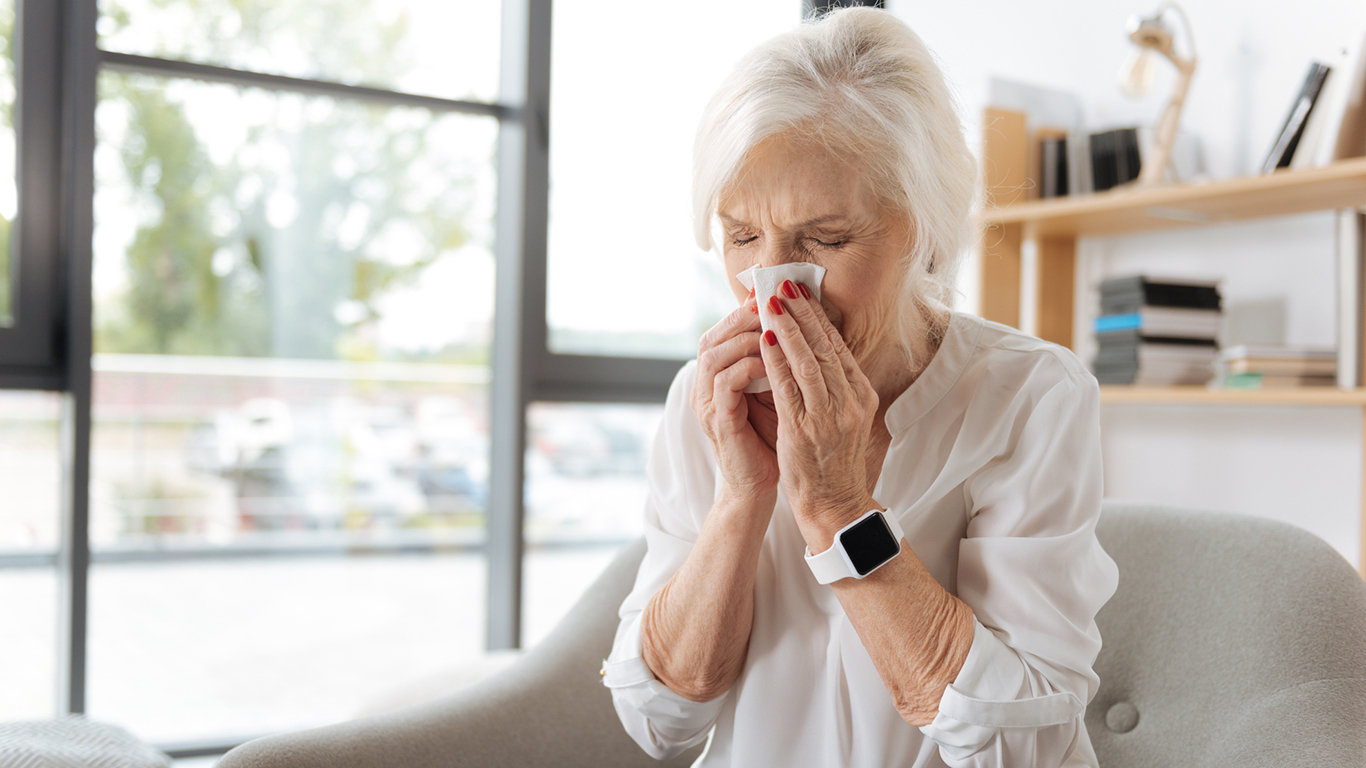
36. Oklahoma
> Flu-like illness activity level: High
> Flu-like symptoms so far this flu season (Oct 1- Jan 13): 3.8% of patients
> Flu-like symptoms in offseason (regional): 4.2% of patients
> 65 and over population: 15.0% (16th lowest)
> 5 and under population: 8.1% (9th highest)
[in-text-ad]

37. Oregon
> Flu-like illness activity level: High
> Flu-like symptoms so far this flu season (Oct 1- Jan 13): 2.3% of patients
> Flu-like symptoms in offseason (regional): 1.4% of patients
> 65 and over population: 16.8% (11th highest)
> 5 and under population: 6.9% (11th lowest)

38. Pennsylvania
> Flu-like illness activity level: Moderate
> Flu-like symptoms so far this flu season (Oct 1- Jan 13): 1.5% of patients
> Flu-like symptoms in offseason (regional): 2.0% of patients
> 65 and over population: 17.4% (7th highest)
> 5 and under population: 6.7% (9th lowest)

39. Rhode Island
> Flu-like illness activity level: Moderate
> Flu-like symptoms so far this flu season (Oct 1- Jan 13): 1.0% of patients
> Flu-like symptoms in offseason (regional): 1.4% of patients
> 65 and over population: 16.5% (13th highest)
> 5 and under population: 6.2% (4th lowest)
[in-text-ad-2]

40. South Carolina
> Flu-like illness activity level: High
> Flu-like symptoms so far this flu season (Oct 1- Jan 13): 3.9% of patients
> Flu-like symptoms in offseason (regional): 1.9% of patients
> 65 and over population: 16.7% (12th highest)
> 5 and under population: 7.0% (16th lowest)

41. South Dakota
> Flu-like illness activity level: High
> Flu-like symptoms so far this flu season (Oct 1- Jan 13): 2.3% of patients
> Flu-like symptoms in offseason (regional): 1.3% of patients
> 65 and over population: 15.9% (23rd highest)
> 5 and under population: 8.5% (4th highest)
[in-text-ad]
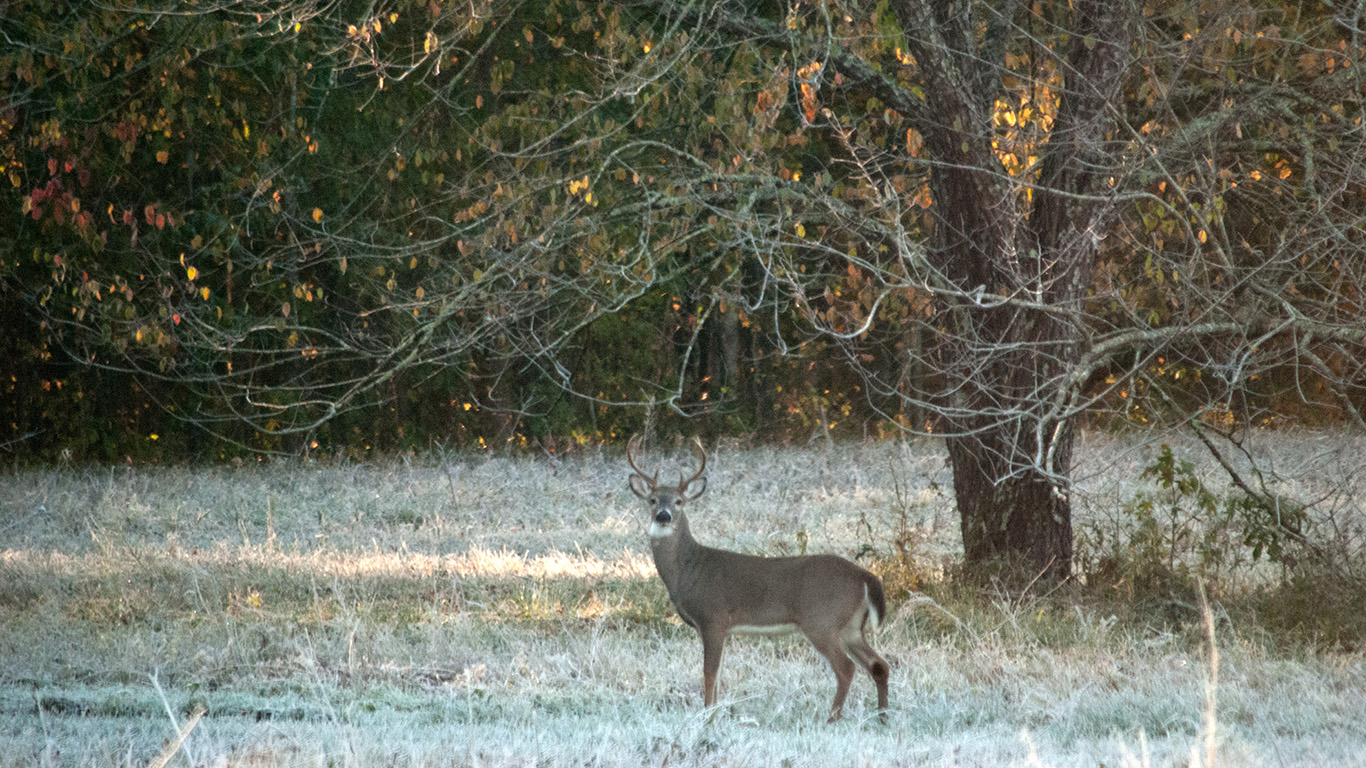
42. Tennessee
> Flu-like illness activity level: High
> Flu-like symptoms so far this flu season (Oct 1- Jan 13): 1.9% of patients
> Flu-like symptoms in offseason (regional): 1.9% of patients
> 65 and over population: 15.7% (25th highest)
> 5 and under population: 7.3% (24th highest)
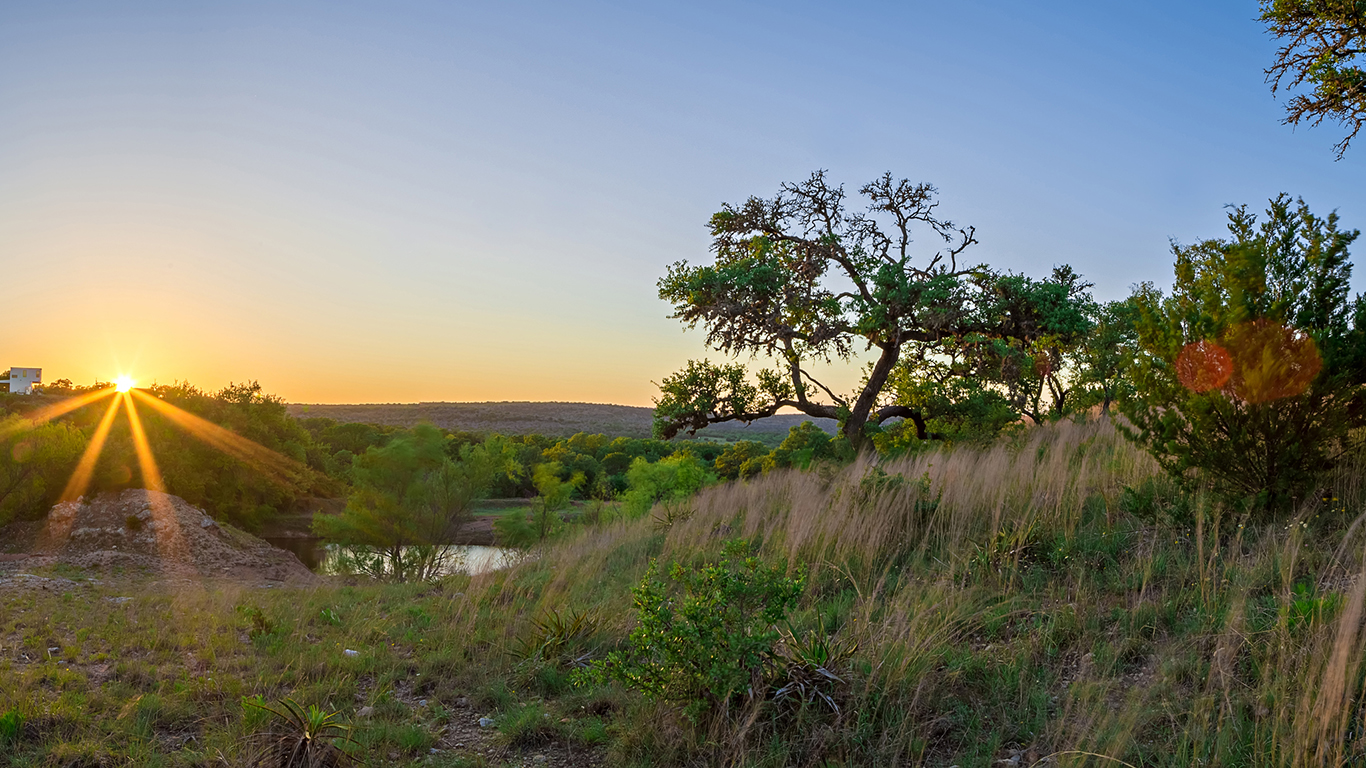
43. Texas
> Flu-like illness activity level: High
> Flu-like symptoms so far this flu season (Oct 1- Jan 13): 6.1% of patients
> Flu-like symptoms in offseason (regional): 4.2% of patients
> 65 and over population: 12.0% (3rd lowest)
> 5 and under population: 8.6% (3rd highest)

44. Utah
> Flu-like illness activity level: Low
> Flu-like symptoms so far this flu season (Oct 1- Jan 13): 0.5% of patients
> Flu-like symptoms in offseason (regional): 1.3% of patients
> 65 and over population: 10.5% (2nd lowest)
> 5 and under population: 10.0% (the highest)
[in-text-ad-2]
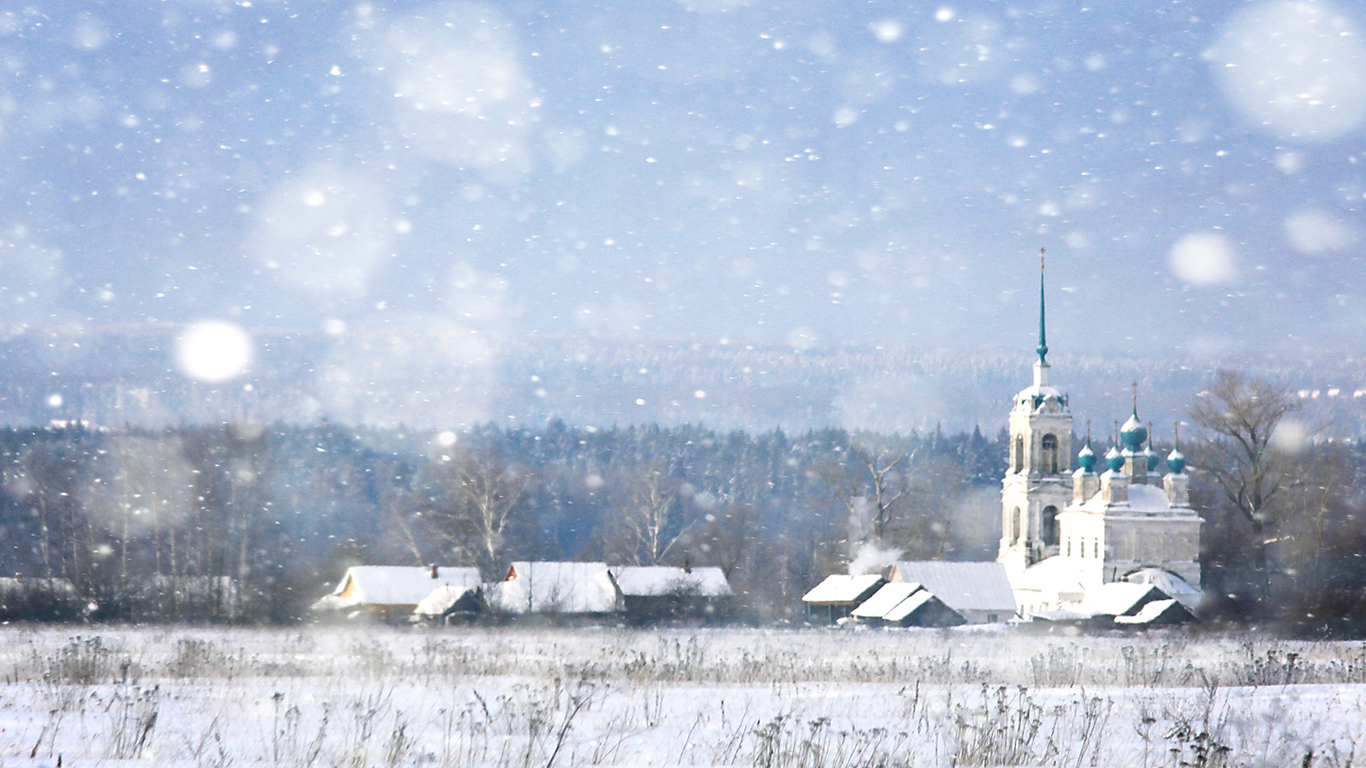
45. Vermont
> Flu-like illness activity level: Low
> Flu-like symptoms so far this flu season (Oct 1- Jan 13): 1.3% of patients
> Flu-like symptoms in offseason (regional): 1.4% of patients
> 65 and over population: 18.2% (4th highest)
> 5 and under population: 5.8% (the lowest)

46. Virginia
> Flu-like illness activity level: High
> Flu-like symptoms so far this flu season (Oct 1- Jan 13): 2.5% of patients
> Flu-like symptoms in offseason (regional): 2.0% of patients
> 65 and over population: 14.6% (10th lowest)
> 5 and under population: 7.2% (20th lowest)
[in-text-ad]

47. Washington
> Flu-like illness activity level: Minimal
> Flu-like symptoms so far this flu season (Oct 1- Jan 13): 1.1% of patients
> Flu-like symptoms in offseason (regional): 1.4% of patients
> 65 and over population: 14.8% (12th lowest)
> 5 and under population: 7.4% (22nd highest)
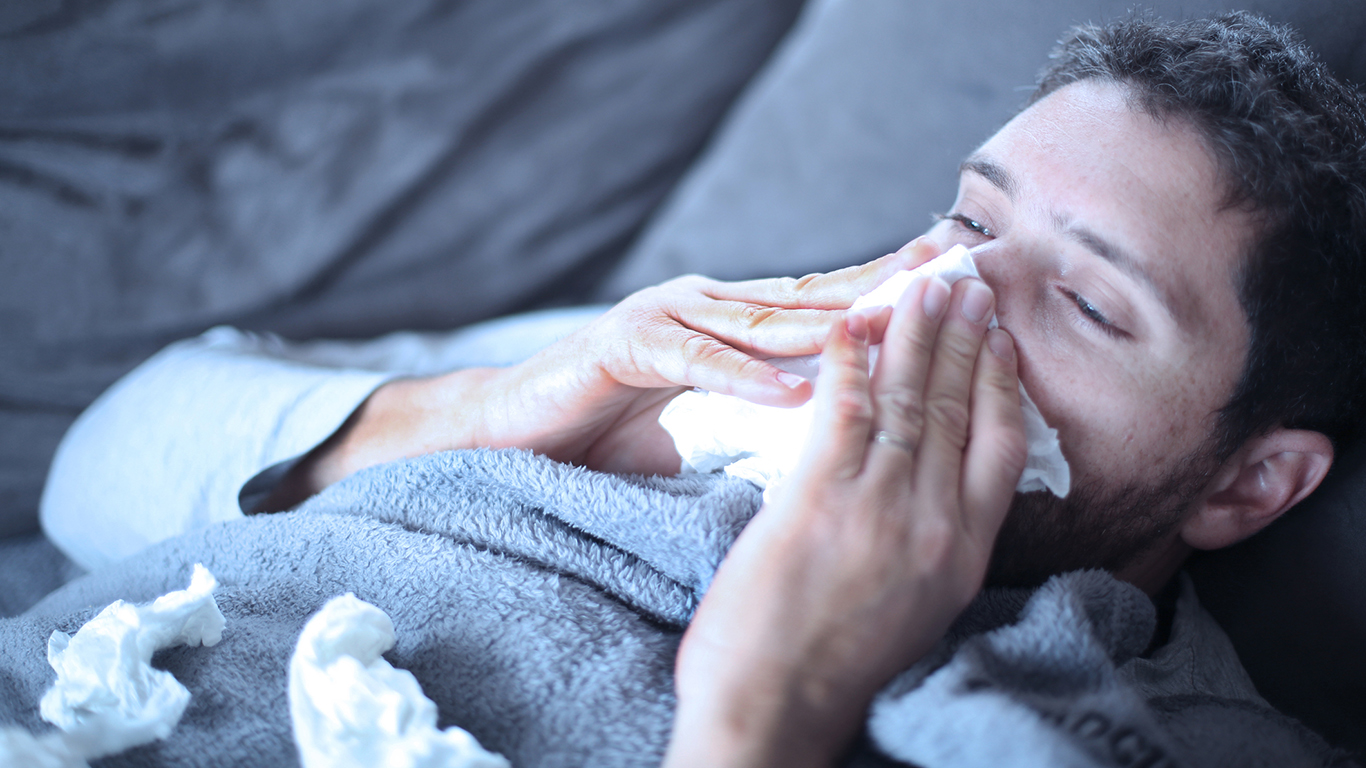
48. West Virginia
> Flu-like illness activity level: High
> Flu-like symptoms so far this flu season (Oct 1- Jan 13): 2.1% of patients
> Flu-like symptoms in offseason (regional): 2.0% of patients
> 65 and over population: 18.8% (3rd highest)
> 5 and under population: 6.6% (8th lowest)

49. Wisconsin
> Flu-like illness activity level: High
> Flu-like symptoms so far this flu season (Oct 1- Jan 13): 2.1% of patients
> Flu-like symptoms in offseason (regional): 1.8% of patients
> 65 and over population: 16.0% (21st highest)
> 5 and under population: 7.0% (13th lowest)
[in-text-ad-2]

50. Wyoming
> Flu-like illness activity level: High
> Flu-like symptoms so far this flu season (Oct 1- Jan 13): 2.4% of patients
> Flu-like symptoms in offseason (regional): 1.3% of patients
> 65 and over population: 15.0% (13th lowest)
> 5 and under population: 7.8% (11th highest)
After two decades of reviewing financial products I haven’t seen anything like this. Credit card companies are at war, handing out free rewards and benefits to win the best customers.
A good cash back card can be worth thousands of dollars a year in free money, not to mention other perks like travel, insurance, and access to fancy lounges.
Our top pick today pays up to 5% cash back, a $200 bonus on top, and $0 annual fee. Click here to apply before they stop offering rewards this generous.
Flywheel Publishing has partnered with CardRatings for our coverage of credit card products. Flywheel Publishing and CardRatings may receive a commission from card issuers.
Thank you for reading! Have some feedback for us?
Contact the 24/7 Wall St. editorial team.